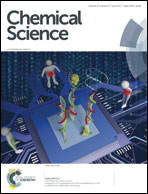Tris[(1-isopropylbenzimidazol-2-yl)dimethylsilyl]methyl metal complexes, [TismPriBenz]M: a new class of metallacarbatranes, isomerization to a tris(N-heterocyclic carbene) derivative, and evidence for an inverted ligand field†
Abstract
The tris[(1-isopropylbenzimidazol-2-yl)dimethylsilyl]methyl ligand, [TismPriBenz], has been employed to form carbatrane compounds of both the main group metals and transition metals, namely [TismPriBenz]Li, [TismPriBenz]MgMe, [TismPriBenz]Cu and [TismPriBenz]NiBr. In addition to the formation of atranes, a zinc compound that exhibits κ3-coordination, namely [κ3-TismPriBenz]ZnMe, has also been obtained. Furthermore, the [TismPriBenz] ligand may undergo a thermally induced rearrangement to afford a novel tripodal tris(N-heterocyclic carbene) variant, as shown by the conversion of [TismPriBenz]Cu to [κ4-C4-TismPriBenz*]Cu. The transannular M–C bond lengths in the atrane compounds are 0.19–0.32 Å longer than the sum of the respective covalent radii, which is consistent with a bonding description that features a formally zwitterionic component. Interestingly, computational studies demonstrate that the Cu–Catrane interactions in [TismPriBenz]Cu and [κ4-C4-TismPriBenz*]Cu are characterized by an “inverted ligand field”, in which the occupied antibonding orbitals are localized more on carbon than on copper.
![Graphical abstract: Tris[(1-isopropylbenzimidazol-2-yl)dimethylsilyl]methyl metal complexes, [TismPriBenz]M: a new class of metallacarbatranes, isomerization to a tris(N-heterocyclic carbene) derivative, and evidence for an inverted ligand field](/en/Image/Get?imageInfo.ImageType=GA&imageInfo.ImageIdentifier.ManuscriptID=C7SC00499K&imageInfo.ImageIdentifier.Year=2017)


 Please wait while we load your content...
Please wait while we load your content...